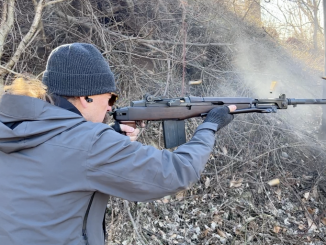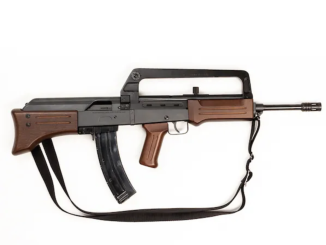The Beretta M1918 was one of two simultaneous efforts to turn the M1915 Villar-Perosa machine gun into a more practical weapon. The Officine Villar Perosa (who had manufactured the 1915 gun in the first place) did one version, and Beretta did the other. In fact, Beretta’s version was the work of none other than Tullio Marengoni – he would continue to work at Beretta for decades, and produce many of their most iconic pistol and submachine gun designs.
Anyway, both efforts were based on splitting the Villar Perosa into two separate receivers, and then designing a stock, sights, and trigger mechanism to make them viable shoulder weapons. The basic Villar Perosa action (open-bolt, slightly delayed blowback, 9mm Glisenti from 25-round top-mounted magazines) was kept intact, and one will recognize elements like the bolt handle, receiver end cap, and magazine catch from those original guns.
Beretta and Marengoni adapted a Carcano-style stock to the gun, and also fitted it with a folding cavalry-style spike bayonet. The version pictured here is actually a semi-automatic only carbine – a select-fire version was also made with what would become Beretta’s standard dual trigger FCG, as well as a single-trigger variant with a semi/full selector switch.
Reportedly 4000-5000 of these guns were delivered (of all varieties combined), and the stock of existing Villar-Perosa guns were broken up to provide the components for the M1918 guns (which helps explain why so few 1915 Villar Perosas survive today). These were introduced into service in 1918, and some sources suggest they actually saw service a few weeks before the first German MP-18 submachine guns, which would make them the first formal SMG used in combat. That exact point is disputed, but regardless they did see limited use right at the end of WWI, and continued in service through the end of WWII.
Courtesy of the National Firearms Centre in Leeds, we have a bunch of photos of an M1918 SMG:































“delayed blowback”
Source?
Villar Perosa RoF is 3000 rpm (whole weapon) or 1500 rpm (single barrel), considering that it doesn’t look to be delayed, 1500 is more than many WW2 era blow-back sub-machine guns (MP 34: ~600rpm, Lanchester: ~600rpm, PPSh: ~1000rpm)
“which would make them the first formal SMG used in combat.”
Anyway, Villar-Perosa was first fire-arm produced intentionally as a aerial warfare weapon. Now usage of sub-machine gun in aerial combat might be seen as a joke, but in early stage of WW1 it was alternative to revolver/automatic pistol/repeating rifle so it give a big advantage in rate-of-fire.
The bolt handle rides in a slot that forces the bolt to turn 45° as is opens. This is the delay although as you’ve figured, it does almost nothing to slow the rate of fire. Very short (~40mm) bolt travel, heavy springs and a light bolt – the usual suspects make the rate of fire so high.
Interesting sight arrangement, odd that they placed them on the right instead of the left in that era. Also I love the combination of early sub-gun and Carcano carbine visual features.
The somewhat underpowered Glisenti round wouldn’t do much good for anyone who had to fend off attackers in a trench but given the ludicrously high rate of fire of the Villar-Perosa action, one would not want a full magazine of Glisenti in the gut or in the face…
I’ve always been impressed with the thoughtful features Marengoni added to make the design more “user-friendly”. Like that external “chute” around the ejection port on the underside, which kept you from inadvertently placing your off hand over the port and getting a palm-full of hot brass.
The top-mounted magazine was inherited from the Villar-Perosa, of course, but as with the later Australian Owen and F1 SMGS, it pretty much guarantees reliable feeding, not to mention making prone firing a good bit easier than with a magazine in the “conventional” upward feeding position.
Fun fact; the “90-degree pivot” feeding magazines, parallel to the barrel, of the HK G-11 and FN P-90 are nothing new. In Canada, Anton Roscziewski’s Model 2 experimental 9mm SMG used the same arrangement sixty-some years ago. It also had a bolt system very like a G-3 rifle, and a selective-fire trigger similar to an MG34.
There is more than one way to put a magazine in.
cheers
eon
““90-degree pivot” feeding magazines, parallel to the barrel”
It traces back at least to 1930s – see US Patent 2041015A here from 1934:
http://www.google.com/patents/US2041015
I will not be surprised if older patents for similar solution exist.
For some reason they used trigger guard from Vetterli rifles. Possible whole stocks were recycled?
Italian submachine guns of the period between the wars were well thought out and very easy to use.
Weapon of choice scenario:
I love traveling in style, but being on an airship that’s getting boarded midair by sky pirates isn’t my style!! Get a gun from this closet and DO SOMETHING!!!!! By the way, this airship isn’t filled with hydrogen, so don’t think we’re about to spark anything.
1. Villar-Perosa double barrel configuration
2. Furrer Flieger Doppelpistole M1919
3. Beretta M1918
4. Mauser C96 long barrel carbine variant
5. Colt 1911 or Pocket Hammerless
6. Webley-Fosbery automatic revolver
7. Mauser Standard Model rifle with double trigger or Hanyang 88 (how it got in here I will never know)
8. Remington Model 8
9. Burgess folding shotgun
10. Winchester 1897 with bayonet
11. Parabellum MG 14
12. Or per the usual, screw the budget and add your favorite toys to this list
If, however, you are coming to the rescue, how will you travel?
1. Hawker Nimrod
2. Focke-Wulf FW 56
3. Curtiss Sparrow Hawk
4. Polikarpov I-5
5. Screw this! Throw Gremlins at the pirates!!!!
This activity is totally voluntary. You are not required to participate if you do not wish to do so. Please keep any and all criticism of this post humane and free of foul language.
Thank you,
Cherndog
“Curtiss Sparrow Hawk”
For other parasite fighter see Vakhmistrov Zveno:
https://en.wikipedia.org/wiki/Zveno_project
“how will you travel”
Bartini Stal-6 (one of early R.L.Bartini designs, as many of its ahead of its time so never enter mass production /Stal-8 fighter version never go beyond project stage/, most Bartini designs never go beyond prototype stage despite promising parameters, so far I know only DB-240 long-range twin-engine inverted-gull-wing bomber was mass produced)
“I love traveling in style”
Then see Der Luftpirat und sein lenkbares Luftschift.
http://ratmmjess.tripod.com/mors.html
Or if you believe in rule “MORE ENGINES = BETTER” get Tupolev ANT-20
“Mauser C96 long barrel carbine variant”
Or maybe multiple Mauser C96 stand?
http://www.peashooter85.com/post/131768016037/cerebralzero-myexternalmemory-error888
That would definitely hurt. I’m not sure anyone can recover from two rows of 5 bullets (per row) stitched into his lungs and heart at “repel boarders” range.
That is astonishing, sort of a semi-auto mitrailleuse. Looks like a desperation measure to try to solve a new kind of problem. Reloading must have been tedious.
It’s starting to play out like the Studio Ghibli film ” Kureani no Buta. Personally I’ll take the Burgess and do a whippet.
I would go with the Winchester 97 with bayonet because I have a great deal of respect for what a shotgun can do as a close range defensive weapon, and I know the Winchester to be a reliable gun if well maintained.
For the airplane, I would go with the Curtiss Sparrow Hawk because it can link itself to an airship in flight if the airship is properly equipped for that.
Odd thing, my reaction to the photos of the Beretta m1918 was “Oh, look, a steampunk buzzgun!” So I suppose Cherndog and I are thinking along similar lines about this.
Wow. This thing should be photographed by C&Rsenal.
less lethal paintball version:
http://www.mcarterbrown.com/forums/custom-projects-custom-questions/274753-beretta-1918-smg-anyone-think-cool.html
http://i447.photobucket.com/albums/qq191/commanderl2a3/DSCN3989.jpg